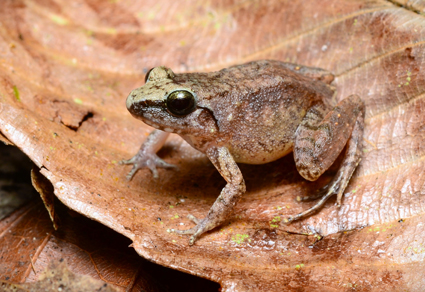Abstract
Limnonectes hascheanus and Limnonectes limborgi are two very similar-looking and closely related species and are sometimes referred to as the Limnonectes hascheanus-limborgi complex (Inger & Stuart 2010). Inger & Stuart (2010) tackled the systematics of the complex and confirmed the status of L. limborgi as a distinct species and not a junior synonym to L. hascheanus by providing molecular data and morphological characters of its distinctiveness. The geographic ranges of the two species were also reported to be distinct where L. hascheanus is mainly restricted to the southern part of the Thai-Malay Peninsula while L. limborgi is distributed from southern Myanmar north into northern Thailand and Laos before curving around into central Laos, northeastern Thailand, Cambodia, and southern Vietnam (Inger & Stuart 2010).
References
- Frost, D.R. (2023) Amphibian Species of the World: an Online Reference. Version 6.2. Electronic Database. American Museum of Natural History, New York, USA. Available from: https://amphibiansoftheworld.amnh.org/index.php (accessed 2 November 2023)
- Hong, Z., Shahrul, A.M.S., Grismer, L.L. & Quah, E.S.H. (2021) Preliminary report on the herpetofaunal diversity of Batu Hampar Recreational Forest, Kedah, Malaysia. Check List, 17(3), 791–814. https://doi.org/10.15560/17.3.791
- Huang, J., Li, Z., Liu, X., Stuart, B.L., Yuan, Z. & Zhao, H. (2022) The phylogenetic status of Limnonectes liui (Yang, 1983) (Anura: Dicroglossidae) based on mitochondrial genes and its taxonomic implications. Zootaxa, 5092 (1), 116–26. https://doi.org/10.11646/ZOOTAXA.5092.1.6
- Inger, R.F. & Stuart, B.L. (2010) Systematics of Limnonectes (Taylorana) Dubois. Current Herpetology, 29 (2), 51–68. https://doi.org/10.3105/018.029.0201
- K. Lisa Yang Center for Conservation Bioacoustics (2023) Raven Pro: Interactive Sound Analysis Software Version 1.6.4. Computer software. The Cornell Lab of Ornithology, Ithaca, New York. Available from: https://ravensoundsoftware.com/software/raven-pro/ (accessed 11 July 2023)
- Köhler, J., Jansen, M., Rodriguez, A., Kok, P.J., Toledo, L.F., Emmrich, M., Glaw, F., Haddad, C.F., Roedel, M.O. & Vences, M. (2017) The use of bioacoustics in anuran taxonomy: theory, terminology, methods and recommendations for best practice. Zootaxa, 4251 (1), 1–24. https://doi.org/10.11646/ZOOTAXA.4251.1.1
- Köhler, G., Zwitzers, B., Than, N.L., Gupta, D.K., Janke, A., Pauls, S.U. & Thammachoti, P. (2021) Bioacoustics reveal hidden diversity in frogs: Two new species of the genus Limnonectes from Myanmar (Amphibia, Anura, Dicroglossidae). Diversity, 13 (9), 399. https://doi.org/10.3390/d13090399
- Matsui, M., Nishikawa, K. & Eto, K. (2014) A new burrow-utilising fanged frog from Sarawak, East Malaysia (Anura: Dicroglossidae). Raffles Bulletin of Zoology, 62, 679–87.
- Oksanen, J., Blanchet, F.G., Friendly, M., Kindt, R., Legendre, P., McGlinn, D., Minchin, P.R., O’Hara, R.B., Simpson, G.L., Solymos, P., Stevens, M.H.H., Szoecs, E. & Wagner, H. (2020) Package ‘vegan’. Version 2.5-7. [https://cran.r-project.org/web/packages/vegan/]
- Quah, E.S.H., Badli-Sham, B.H., Rahman, M.F-S.A., Ahmad, A. & Chan, K.O. (2021) A new record and range extension for Philautus davidlabangi Matsui, 2009 from Peninsular Malaysia (Amphibia: Rhacophoridae). Herpetology Notes, 14, 1181–1186.
- Seger, K.R., da Veiga Teixeira, B.F., Annibale, F.S., Rossa-Feres, D., Lima, A.P., Andrade, G.V., Giaretta, A.A. & Lourenço, L.B. (2021) Five Independent Lineages Revealed by Integrative Taxonomy in the Dendropsophus nanus–Dendropsophus walfordi Species Complex. Diversity, 13 (11), 522. https://doi.org/10.3390/d13110522
- Stoliczka, F. (1870) Observations on some Indian and Malayan Amphibia and Reptilia. Proceedings of the Asiatic Society of Bengal, 1870, 103–109. https://doi.org/10.1080/00222937008696209
- Sueur, J., Aubin, T. & Simonis, C. (2008) Seewave, a free modular tool for sound analysis and synthesis. Bioacoustics, 18 (2), 213–226. https://doi.org/10.1080/09524622.2008.9753600
- Wijayathilaka, N. & Meegaskumbura, M. (2016) An acoustic analysis of the genus Microhyla (Anura: Microhylidae) of Sri Lanka. PloS one, 11 (7), e0159003. https://doi.org/10.1371/journal.pone.0159003
- Wijayathilaka, N., Senevirathne, G., Bandara, C., Rajapakse, S., Pethiyagoda, R. & Meegaskumbura, M. (2018) Integrating bioacoustics, DNA barcoding and niche modelling for frog conservation–The threatened balloon frogs of Sri Lanka. Global Ecology and Conservation, 16, e00496. https://doi.org/10.1016/j.gecco.2018.e00496


